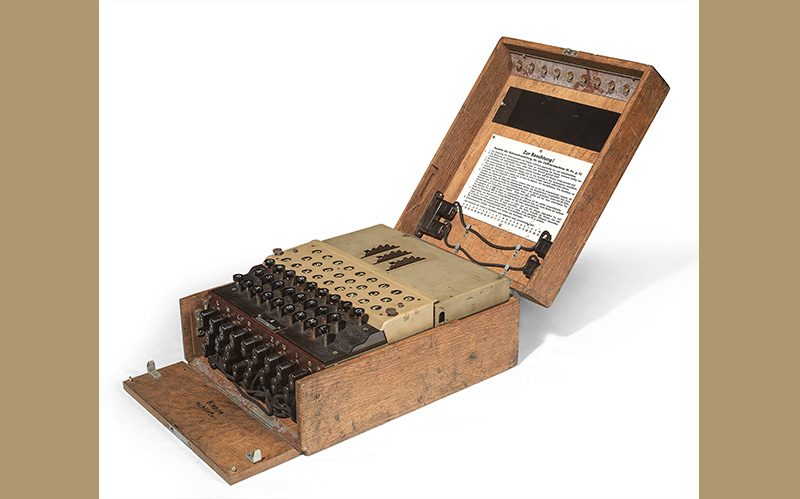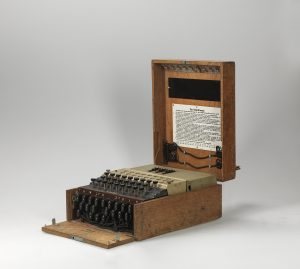
Enigma is probably the most famous encryption machine in the world. It played a key role in the Second World War. One of the few surviving specimens is due to be auctioned at Dorotheum on 3 December.
Probably the most famous encryption machine in the world
Data protection in fields ranging from email to Internet banking is a major issue in the digital age. It is supported by cryptography, the – mostly secret – practice and study of information encryption and decryption.
This was different in the pre-computer era, when cryptography was based on secret scripts or ciphers until electro-mechanical machines took over in the 20th century. One such ciphering machine played a crucial political role in the Second World War: Enigma.
One of those rare objects was sold at Dorotheum in June 2020 for a record price of 117,800€.
The greatest Invention

Berlin 1944, Heimsoeth und Rinke, Seriennummer “20483, Metallgehäuse, mit drei Walzen (III, IV und V), Umkehrwalze B und Steckerbrett, Holzkasten (geschlossen) ca. 38 x 28 x 15,5 cm
erzielter Preis € 117.800
Enigma was invented by the German electrical engineer Arthur Scherbius (1878–1929), who first applied for a patent in 1918. Because the German military showed little interest at the time, Enigma initially went on sale on the civil market. The German military only started using it in 1926; soon afterwards, production was restricted to this sole purpose. Increasing political tensions and armament in the wake of Hitler’s takeover made Enigma the most important ciphering system for the German military. It was mainly used by the Luftwaffe, the Kriegsmarine and the German army, but also by diplomatic services and the Reichsbahn. The Germans believed Enigma to be undecipherable and therefore absolutely secure. By 1939 its key space had exceeded an incredible 100 sextillion, which amounts to approximately 1023 permutations.
Of course no-one suspected that radio messages encrypted by the German wonder machine were being intercepted and cracked by an armada of cryptographers on the grounds of Bletchley Park, an idyllic estate located 45 miles north of London, where cryptanalysts like Alfred Dillwyn Knox, William Gordon Welchman, Philip Stuart Milner-Barry and Alan Turing worked feverishly to break the Enigma code. They used an electro-mechanical machine, the “Bombe”. It was developed by Alan Turing and consisted of a serial connection of three sets of twelve triplets of rotating drums from the Enigma machine. The “Bombe” was an advanced version of the Polish mathematician Marian Rejewski’s “bomba”.
Cryptonym Ultra
Bletchley Park agents finally managed to decode Enigma-encrypted messages and continued to do so throughout the war, with few exceptions. From January 1940, the British and their allies intercepted secret German radio traffic under the cryptonym “Ultra”. Operation “Ultra” thus enabled the Allied Powers to win the submarine war, if not the whole war, as Winston Churchill saw it.
Enigma remained Great Britain’s best-kept secret until the 1970s, when finally untypical heroes like Alan Turing came to fame and recognition for their decoding achievements.













